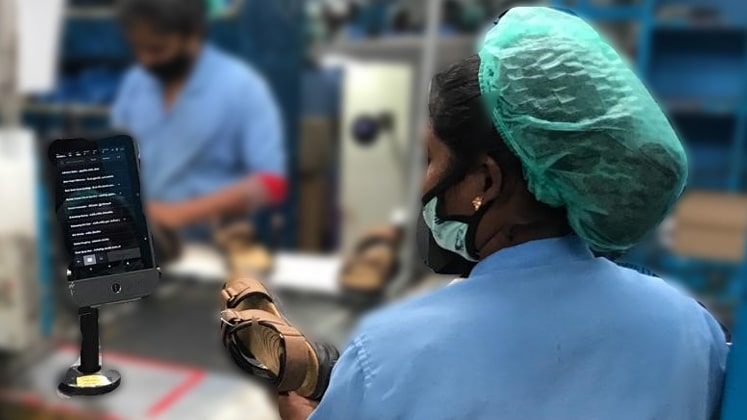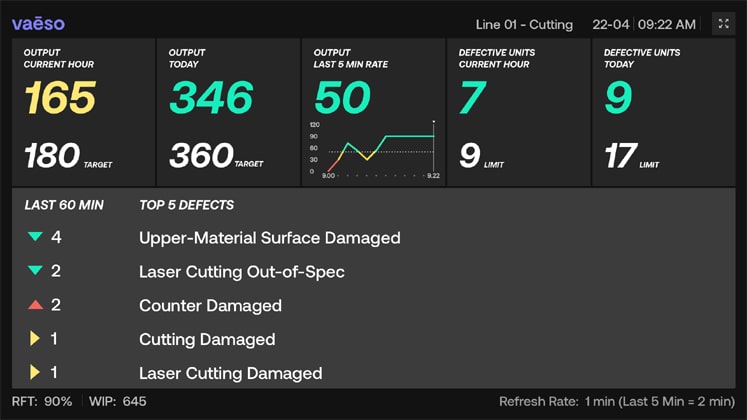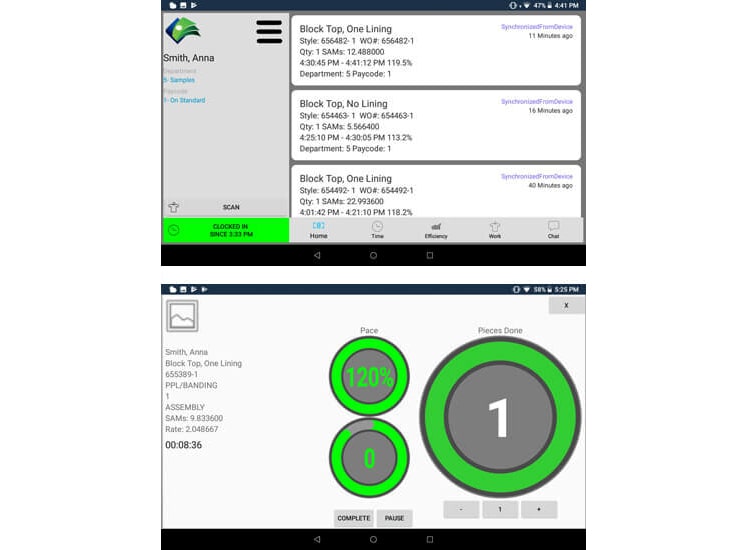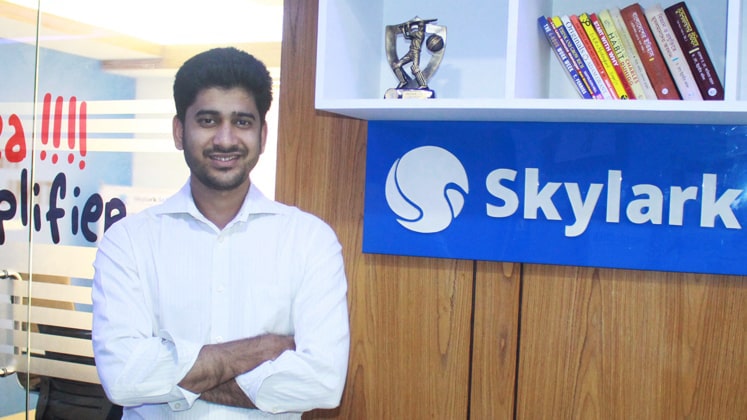
Maintaining affordable prices to customers over an extended period of time has always been a goal and principal challenge for manufacturers in the apparel and textile industry. Post-COVID, as markets recover, the basic to mid-level price-point products are expected to remain in demand. But, with disrupted supply chains due to the disappearance of key material vendors, reduced manpower availability and potential inflation as the industry seeks limited supply, this challenge will be even harder.
So the question arises – how to address this challenge and find out solution? Since most of the processes in an apparel factory take place on the shopfloor, which constitutes the highest process costing after raw material, what is essential for the factories is to pay a serious attention to control and monitor these processes – production and quality in particular, in order to save direct and indirect costs. In this case, the software technology can be of great help.
- Vaēso LIVE – Digital shopfloor execution system for apparel and footwear sector

Asia has become the world’s manufacturing hub due to the availability of low-cost labour and the factory owners have built a shopfloor culture of ‘throwing’ more labour at quality issues or simply changing management when solutions are not readily found. COVID-19 has now amplified the demand for better QUALITY and VALUE as most retailer-brand owners have seen their e-commerce sales increase by 200 per cent, 300 per cent or more. This will dramatically increase the Cost of Poor Quality for the apparel and footwear industry as consumers are much more discerning of poor quality products when they arrive at their homes versus simply asking for a replacement when they are trying on a product in a retail store. Thus, a massive paradigm shift in quality and the required product value has occurred in our industry because of COVID-19.
Building a zero-defect culture where every artisan controls their quality before passing it on to the new workstations is the only means to meeting e-commerce’s demand for a logarithmic improvement in the quality of the products. “Retail-brand owners are looking to build much tighter partnerships with factories who understand this seismic shift and those who are able to transform themselves will see their market share increase dramatically. Those who do not, will most likely not survive,” told Amit Gupta, Regional Director, Impactiva regarding the organisation behind Vaēso digital manufacturing execution system.
Vaēso has built a digital shopfloor system that places a digital device on each workstation so that each artisan/operator becomes responsible for their own quality. With the resulting dramatic improvement in shopfloor quality (from 40 per cent ‘right the first time’ quality to +80 per cent, 90 per cent…), factories will see significant improvements in productivity and material waste reductions that will generate 4x to 12x return on the cost of shopfloor digitalisation.
Adding to this, Amit said that, as an industry, we need to decouple system discipline from having a few key leaders who are the only ones responsible for their execution. “We need to create a bottom-up culture where systems generate engagement of the entire shopfloor so that regardless of the personnel churn rate, process discipline drives a continuous improvement on a month-to-month basis,” asserted Amit.

But, how does one achieve such bottom-up discipline and accountability, digitalisation? It is the fastest and lowest cost way of implementing and maintaining such best-in-class processes and procedures. How many times have factories implemented an important new process and/or procedure and 6 months later it is no longer being followed simply because of a lack of process discipline-ownership or because a few key managers have departed? Digitalisation enforces process discipline via the raising of timely alerts and escalations if the designed processes are not being followed. Furthermore, for some important processes, the software can be designed and configured to stop production if a procedure is not followed. In this way, digitalisation prevents undisciplined shopfloor teams from trying to ‘skip or game a process’.
As far as the core features of Vaēso LIVE Technology are concerned, it uses a cutting edge RFID-enabled technology which captures accurate data on shopfloor automatically eliminating any chance of human error. It then enables the artisans and supervisors of the shopfloor to take responsibility for using the data when manufacturing quality, cycle time and hourly output alerts are generated to take immediate corrective action. It helps to build a culture of accountability and responsibility where an entire Factory Team is engaged to produce defect-free products in the targeted daily output.
Vaēso LIVE also allows factories to provide real-time order status and WIP visibility to buyers eliminating the need to be answering constant requests for such status information. The ability to provide buyers with real-time visibility to the shopfloor data is a competitive game changer for factories.
Case Study:
Farida Shoes Pvt. Ltd., one of the leading exporters of footwear from India, has been using Vaēso LIVE for the past 14 weeks. The improvement in quality and productivity is impressive:
- Right the first time quality: +30 per cent
- Productivity: +30 per cent
- Reduced product and component recuts-replacements: -47 per cent
“I am sure that going digital is the present and future of the industry. At Farida, we are very happy that we started with Vaēso and are thus 2 months ahead of the rest of the industry by having visibility of our manufacturing shopfloor and being able to share relevant real-time information with our customers. We believe Vaēso to be the bridge for our industry’s digital future,” commented Irshad Ahmed Mecca, Managing Director, Farida Shoes Pvt. Ltd.
- TexTempo (USA) – Promising shopfloor process digitisation and solution provider
US-based shopfloor technology expert TexTempo believes that the quality is probably the largest indirect cost area in a traditional apparel factory along with non-value-added activities, which create excess labour. Apart from this, the ‘lack of visibility’ within a factory premises also causes excessive costs for managing delivery and expediting. Greg Hathcox, Sr. Vice President of Sales, TexTempo told Apparel Resources, “I had a VP level manager tell me that he spent 25 per cent of his time searching for orders on the factory floor while operating a conventional factory,” adding, “We have 30+ years of experience in selling automation to apparel and other sewn products’ manufacturers. We work with manufacturers to help solve issues on their factory floors and prescribe the best solutions to fit their problem. Our long-term vision is to offer real-time visibility of all aspects of the factory floor and offer the tools to improve any part of the production process.”
Pointing out towards a major issue in the US apparel manufacturing industry where still a majority of the factories are operating to cater to small batch production system, Greg commented that the small batch production is usually one-piece flow. Shopfloor systems were originally used in bundle type operations (mass production) where individual performance measurement was a key component. With one piece flow, companies are using cell/group/team configurations, where the individual performance is not tracked as closely.
This is where TexTempo is playing a crucial role to support small batch production with digitisation through its partner companies – IPE and FreePoint Technologies. IPE handles labour/WIP tracking and incentive payroll automation, while FreePoint offers machine utilisation optimisation. The company wants to show manufacturers the full picture of labour/WIP/Machines so that they can focus on continuous improvement resources in the correct area. “Most companies we work with have told us that their factory floors are a ‘black hole’ as orders go in and they hope for the best and find out when the order is ready to ship,” shared Greg.

IPE comes in two modules – IP-RealTime and IP-Batch. IPE has changed the game with IP RealTime incentive payroll and shopfloor control solution. This simple and affordable to deploy and use solution, as says TexTempo, streamlines incentive and hourly payroll tasks, while giving factories better tools to manage the day-to-day operation of all their production activities. From issuance of the production order, to production data collection and gross payroll processing, IP RealTime streamlines plant-wide processes. Data collection is managed through standard Wi-Fi and off-the-shelf Android devices to keep it simple and affordable. Therefore, IP RealTime empowers supervisors and managers to quickly track order status, monitor individual and team productivity, resolve quality issues, manage off-standard events and better balance production lines.
On the other hand, IP-Batch solution helps manage operations, styles and cut orders. The printing of bar-coded bundle tickets, submitted on gum sheets makes data collection easy via a USB hand-held scanner. Pay Codes are defined to calculate both on standard and off standard pay, as well as make-up (daily or weekly), overtime premium, small bundle premium and shift differential pay. Each of these gross pay types can then be consolidated and transferred to a gross-to-net payroll system (ADP, PayChex, Performance Payroll or .csv file). The system can also be set-up to manage a single sewing plant or configured for central cutting/remote sewing. Furthermore, IP-Batch can be integrated with 3rd party ERP systems to eliminate double entry of data.
Automation of incentive payroll is something TexTempo feels is a real necessity in today’s time which can offer a productivity improvement of 20-30 per cent over traditional hourly based pay systems where average 7-12 minutes per day per employee get wasted. “The IP system is very user-friendly. The company offers excellent customer support, and the product offering has better information available than any programme I have ever used,” Tom Dyer, Plant Manager, Visual Impulse Company – a US-based cut and sew company, which uses IP system offered by TexTempo.
Therefore, the software solutions offered by TexTempo help apparel factories increase visibility by digitally tracking each order/bundle/unit in real time as it moves through the factory. It collects data on labour, WIP, machine utilisation and then this data measures the performance, which is then reported back through dashboards/reports allowing management to avoid mistakes and seize opportunities immediately.
- Skylark Soft – One of the first shopfloor digitisation solutions in Bangladesh
Needless to say how big RMG manufacturing industry is in Bangladesh! However the country is not known to develop technology for the sector on its own but Skylark Soft has changed the equation with an indigenously developed shopfloor control technology – PROTRACKER.
PROTRACKER is fully customisable and cloud-based real-time production tracking software for apparel industry that manages the entire production process – right from managing order details to production, shipping to invoicing which can be completely integrated with any other management software.
The biggest issue a factory can face is the management of unstructured data within different departments which causes anomaly in long run, especially in a country like Bangladesh where manufacturing is undoubtedly strong but it still counts amongst those countries which work on low efficiency and productivity. PROTRACKER, which is the first ‘Made in Bangladesh’ cloud-based software for production tracking, has solution for this prolonged challenge.

B M Shorif, CEO, Skylark Soft Limited, informed Apparel Resources, “Using PROTRACKER, factories can increase their productivity by around 15 per cent within months of implementation. We take only 1 month for implementing PROTRACKER successfully in a factory.”
Tracking of floor production depends on multiple factors and attributes. For apparel industry, production tracking starts with confirmed order quantity when fabric arrives based on PO quantity. Upon fabric arrival, the main workflow of the shopfloor production monitoring system starts and that’s where PROTRACKER operation too starts. A user collects all the necessary information like lay chart size grading and ratios to create bundles cards. A bundle card is a piece of paper which contains a specific barcode with significant amounts of data like buyer, style, size, cutting quantity, etc.
After this, the bundle card needs to be tied with a fabric cut panel as like the normal apparel process maintaining bundle quantity to cut panel quantity. When this is done, the software can specifically track these bundles by scanning in different sections. Meanwhile, all the reports for the cutting section are generated automatically because of the initial data and bundle card processing.
For embellishment style, specific bundles are sent to the print/embroidery factory for scanning. Users then send those bundles with scanned barcodes into the system where automatic invoice, as well as date-wise style in and out data reports, is generated.
When operation is finished, these specific bundles are received by another scanning point and a rejection comparison is prepared. If there is any rejection in panel system, the software makes a way to put rejection data for that specific bundle.
Upon receiving from print/embroidery, the factory’s bundles tend to be sent to the sewing line for input or sometimes put into a tag for next day input. For solid styles, which contain no embellishments, direct input into line is given while maintaining a line-wise invoice. Line supervisors create a digital signature for making the approval of those invoices.
Meanwhile, the IE and Planning teams put all the line data and style-wise SMV and efficiency data which prepares line-wise dashboard when bundles are inputted into line and sewing production starts.
When sewing operation is completed, the bundles are scanned into the system after quality check. PROTRACKER system collects second to second production data and compares it with the given target to IE team and with given SMV, using AI and smart TV which represent all the floor and line activities by dashboard and graphs.
Line QC puts alterations and rejection data for specific items. When sewing production is completed, all finished bodies are sent to the washing factory if needed. When washing is completed garments are received and finally proceed with poly and packing as per packing list.
“The operator can put rejection quantity if he gets any rejection from print/embroidery/washing/sewing and all the final reports can be generated in PROTRACKER. There are two barcodes in the system: one is for original part and other one is for rejected work piece. When the user scans this particular portion or barcode, a popup will be there which will show how many rework and rejection pieces are there in the bundle,” said Shorif.
Currently, Bangladesh is the only country where PROTRACKER is making its space; however, Skylark is aggressively working to broaden its horizon. It has plans to work with overseas manufacturing companies located in countries such as India, Vietnam and Indonesia. “We have implemented our solution in 20 factories in Bangladesh right now and factories such as Mondol Group, Dekko Group, GMS Composite Knitting Ind. Ltd., Padma Textiles and so on are our clients,” claimed Shorif optimistically.
Case Study:
Saturn Textile Limited: Increasing efficiency, saving manpower, reducing time and cost with PROTRACKER
Saturn Textile Limited is one of the top knitwear manufacturers based in Bangladesh and produces over 80 million pieces per annum. In the production lines, the company was facing low efficiency, more time was being consumed, cash flow was irregular and manpower utilisation was huge. To solve this challenge, Saturn Textile Limited deployed PROTRACKER to their production panel powered by Skylark Soft Limited.
Benefits and comparison
By deploying PROTRACKER, Saturn Textile Limited got benefited rapidly. Before using PROTRACKER, the company had just 56 per cent production efficiency. But, currently they are producing their products by 68 per cent production efficiency. PROTRACKER helped to boost their efficiency by raising 12 per cent.
On the other hand, the company successfully saved the cost of 27 people from a total of 1,796 manpower. “We have become more transparent in our reporting system. From our production panel, by gaining productivity, we are saving almost BDT 40 Lakh (US $ 47,184) in a month by only using PROTRACKER,” said Saturn Textile Limited.






